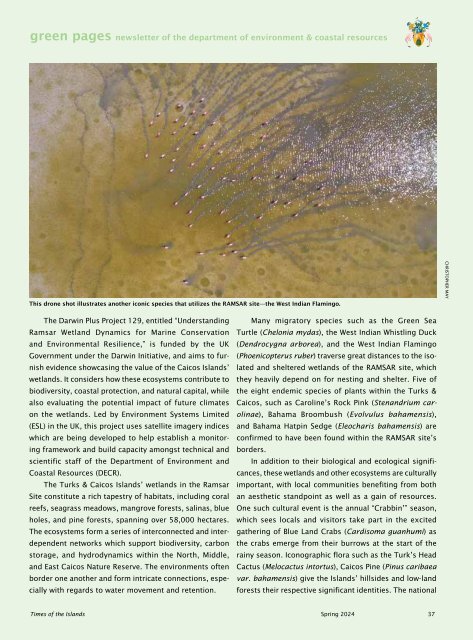Times of the Islands Spring 2024
Presents the "soul of the Turks & Caicos Islands" with in-depth features about local people, culture, history, environment, real estate, businesses, resorts, restaurants and activities.
Presents the "soul of the Turks & Caicos Islands" with in-depth features about local people, culture, history, environment, real estate, businesses, resorts, restaurants and activities.
Create successful ePaper yourself
Turn your PDF publications into a flip-book with our unique Google optimized e-Paper software.
green pages newsletter <strong>of</strong> <strong>the</strong> department <strong>of</strong> environment & coastal resources<br />
This drone shot illustrates ano<strong>the</strong>r iconic species that utilizes <strong>the</strong> RAMSAR site—<strong>the</strong> West Indian Flamingo.<br />
CHRISTOPHER MAY<br />
The Darwin Plus Project 129, entitled “Understanding<br />
Ramsar Wetland Dynamics for Marine Conservation<br />
and Environmental Resilience,” is funded by <strong>the</strong> UK<br />
Government under <strong>the</strong> Darwin Initiative, and aims to furnish<br />
evidence showcasing <strong>the</strong> value <strong>of</strong> <strong>the</strong> Caicos <strong>Islands</strong>’<br />
wetlands. It considers how <strong>the</strong>se ecosystems contribute to<br />
biodiversity, coastal protection, and natural capital, while<br />
also evaluating <strong>the</strong> potential impact <strong>of</strong> future climates<br />
on <strong>the</strong> wetlands. Led by Environment Systems Limited<br />
(ESL) in <strong>the</strong> UK, this project uses satellite imagery indices<br />
which are being developed to help establish a monitoring<br />
framework and build capacity amongst technical and<br />
scientific staff <strong>of</strong> <strong>the</strong> Department <strong>of</strong> Environment and<br />
Coastal Resources (DECR).<br />
The Turks & Caicos <strong>Islands</strong>’ wetlands in <strong>the</strong> Ramsar<br />
Site constitute a rich tapestry <strong>of</strong> habitats, including coral<br />
reefs, seagrass meadows, mangrove forests, salinas, blue<br />
holes, and pine forests, spanning over 58,000 hectares.<br />
The ecosystems form a series <strong>of</strong> interconnected and interdependent<br />
networks which support biodiversity, carbon<br />
storage, and hydrodynamics within <strong>the</strong> North, Middle,<br />
and East Caicos Nature Reserve. The environments <strong>of</strong>ten<br />
border one ano<strong>the</strong>r and form intricate connections, especially<br />
with regards to water movement and retention.<br />
Many migratory species such as <strong>the</strong> Green Sea<br />
Turtle (Chelonia mydas), <strong>the</strong> West Indian Whistling Duck<br />
(Dendrocygna arborea), and <strong>the</strong> West Indian Flamingo<br />
(Phoenicopterus ruber) traverse great distances to <strong>the</strong> isolated<br />
and sheltered wetlands <strong>of</strong> <strong>the</strong> RAMSAR site, which<br />
<strong>the</strong>y heavily depend on for nesting and shelter. Five <strong>of</strong><br />
<strong>the</strong> eight endemic species <strong>of</strong> plants within <strong>the</strong> Turks &<br />
Caicos, such as Caroline’s Rock Pink (Stenandrium carolinae),<br />
Bahama Broombush (Evolvulus bahamensis),<br />
and Bahama Hatpin Sedge (Eleocharis bahamensis) are<br />
confirmed to have been found within <strong>the</strong> RAMSAR site’s<br />
borders.<br />
In addition to <strong>the</strong>ir biological and ecological significances,<br />
<strong>the</strong>se wetlands and o<strong>the</strong>r ecosystems are culturally<br />
important, with local communities benefiting from both<br />
an aes<strong>the</strong>tic standpoint as well as a gain <strong>of</strong> resources.<br />
One such cultural event is <strong>the</strong> annual “Crabbin’” season,<br />
which sees locals and visitors take part in <strong>the</strong> excited<br />
ga<strong>the</strong>ring <strong>of</strong> Blue Land Crabs (Cardisoma guanhumi) as<br />
<strong>the</strong> crabs emerge from <strong>the</strong>ir burrows at <strong>the</strong> start <strong>of</strong> <strong>the</strong><br />
rainy season. Iconographic flora such as <strong>the</strong> Turk’s Head<br />
Cactus (Melocactus intortus), Caicos Pine (Pinus caribaea<br />
var. bahamensis) give <strong>the</strong> <strong>Islands</strong>’ hillsides and low-land<br />
forests <strong>the</strong>ir respective significant identities. The national<br />
<strong>Times</strong> <strong>of</strong> <strong>the</strong> <strong>Islands</strong> <strong>Spring</strong> <strong>2024</strong> 37
















